Abstract
The evaluation of HAADF-STEM images of a sample with the composition Nb18W16O93 provided new insights into its real structure. The basic structure comprises an intact octahedral framework of the tetragonal tungsten bronze (TTB) type. The partial occupation of the pentagonal tunnels (PT) by metal–oxygen strings determines the oxygen-to-metal ratio (O/ΣM with M = Nb,W). For a large area, the O/ΣM was determined to be 2.755, which is bigger than the value of Nb18W16O93, which is O/ΣM = 2.735. To a large extent, the three-fold TTB superstructure of Nb8W9O47 with a high oxygen content is present (O/ΣM = 2.765). In addition, a new four-fold TTB superstructure was found in small domains. Nb12W11O63 with an O/ΣM = 2.739 obviously accommodates part of the sample’s metal excess compared to the stable phase Nb8W9O47.
1. Introduction
At present, there is a broad interest in niobium tungsten oxides, since they have potential applications as high-performance anode materials in lithium-ion batteries. The recent worldwide research activities were induced in 2018 by a report of extremely fast reversible Li exchange and high cycling stability for the block-type phase Nb16W5O55 and for a sample with the composition Nb18W16O93; the structure of Nb18W16O93 was found to be based on the tetragonal tungsten bronze (TTB) type [1]. This structure type comprises corner-sharing octahedra MO6 that are arranged in such a way that trigonal, square, and pentagonal tunnels arise (Figure 1, bottom left). In the structure of Nb8W9O47, one third of the pentagonal tunnels (PTs) are systematically occupied by metal–oxygen (MO) strings, resulting in a three-fold superstructure of the TTB type (Figure 1, top). The metal inside the PT has a pentagonal bi-pyramidal coordination by oxygen. The unit comprising this polyhedron and the five equatorially connected octahedra is designated a pentagonal column (PC) [2]. Two of such PCs are grouped into pairs by sharing a square of octahedra (so-called diamond link [2]). Four orientations of these PC pairs are possible in the TTB framework, and, at one time, two of them occur in each of the two unit cell orientations of the Nb8W9O47 structure (Figure 1). The three-fold TTB superstructure realized in Nb8W9O47 exhibits high thermodynamic stability, apparently because the interactions between the MO strings inside the TTB substructure are optimized in this arrangement. Iijima and Allpress postulated the following rules for the stable dense packing of PCs [3]: (i) the PTs directly adjacent to a PC (dPC-PT ≈ 0.6–0.65 nm) remain empty; (ii) one of the two PTs with the next-nearest distance to a PC (dPC-PT ≈ 0.9 nm) is occupied, forming a pair of diamond-linked PCs. These rules are strictly obeyed in the structure of Nb8W9O47. Therefore, any deviation from the composition of M17O47 (M = Nb,W) leads to a less ordered real structure. The occupation of directly adjacent PTs, which breaches the first rule, has rarely been observed in TTB-type niobium tungsten oxides up to now. In contrast, the second rule is strictly valid for the composition of M17O47 only, and chains of diamond-linked PCs have frequently been observed in W-richer structural variants, such as Nb6W8O39 (Figure 1) [4].
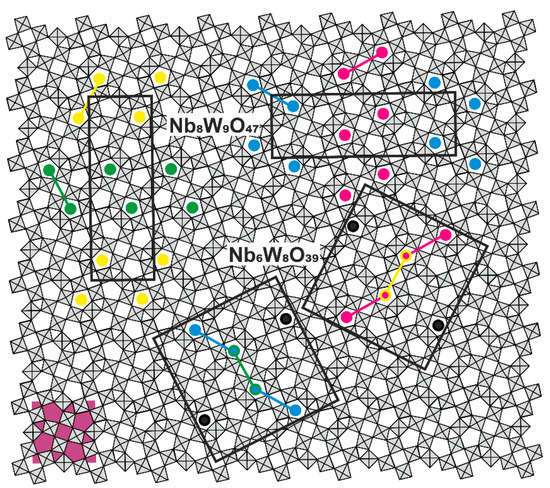
Figure 1.
Structural models of Nb8W9O47 and Nb6W8O39 in projection along [1]. Two possible orientations of both structures are shown (unit cells are framed). Filled pentagonal tunnels (PTs) are represented by filled circles. Pairs of filled PTs (filled circles of same color) are connected via the diamond link (some marked by colored lines). A TTB subcell with composition M10O30 (M = Nb,W) is colored purple.
In 1979, Li-containing phases, such as LixNb8W9O47 with x = 2 and 4, could be synthesized by the reaction of LiNbO3 and WO3 [5]. In 1998, the insertion of Li into Nb8W9O47, by both electrochemical and chemical reactions, could be achieved [6]. A reversible electrochemical uptake of up to 20 Li ions per formula unit was reported for Nb8W9O47 and for the not fully oxidized members of the solid solution series Nb8−xW9+xO47 (1 ≤ x ≤ 6) [7]. As already mentioned above, the electrochemical investigations on TTB-type NbW oxides gained momentum after the study on Nb18W16O93 had been published by Griffith et al. in 2018 [1]. Several follow-up investigations confirmed the outstanding electrochemical performance of samples with this composition [8,9,10,11,12,13]. The orthorhombic structure Nb18W16O93 was proposed by Stephenson in 1968 to explain the split reflections observed in higher-order Laue zones of a twinned crystal with the composition Nb12W11O63 (6Nb2O5:11WO3) [14]. For this composition, congruent melting was found in the course of the exploration of the phase diagram Nb2O5/WO3 by Roth and Waring [15]. The structure of the hypothetical Nb18W16O93 could not be confirmed, neither by single-crystal X-ray diffraction nor by transmission electron microscopy studies [3,16,17]. As both the structural model of Nb18W16O93 and the well-established phase Nb8W9O47 are described by a three-fold TTB superstructure with similar symmetry and practically the same unit cell metric, the differentiation of the two structures by powder XRD is difficult, but possible, if a comparative Rietveld refinement is performed [18]. The difference between these structures is the occupation of PTs in the TTB host lattice, and, thus, the appropriate characterization method is to image the metal positions in the ab plane by high-resolution transmission electron microscopy (HRTEM) [3,19] or by high-angle annular dark field scanning transmission electron microscopy (HAADF-STEM) [20,21,22]. No evidence for the hitherto assumed structural model for Nb18W16O93 was found in the HAADF-STEM images of a sample with this composition. Instead, the observed occupation of the PTs points to a complex intergrowth of two TTB-type phases, as reported in this article.
2. Materials and Methods
2.1. Synthesis
The sample with composition Nb18W16O93 was prepared by the solid-state reaction of Nb2O5 and WO3 powders (molar ratio Nb2O5:WO3 = 9:16). After grinding the powders in an agate mortar, the resulting mixture was pressed into pellets and then annealed in a Pt crucible covered with a Pt lid at 700 °C for 12 h followed by 1200 °C for 12 h. For details, see [12].
2.2. Electron Microscopy
Scanning transmission electron microscopy images (STEM) were recorded on a JEM-ARM300F (JEOL, Japan) using a high-angle annular dark field (HAADF) detector, as described elsewhere [12].
3. Results
The HAADF-STEM images of all the crystal fragments observed along the short crystallographic c axis reveal a defect-free TTB substructure (Figure 2a, Figure 3a and Figure 5a). A close examination of the images shows that most the PTs are empty, as recognized by five bright dots corresponding to a pentagon of octahedra MO6 centered by a black patch. Similarly, filled PTs (PCs) are imaged as a pentagon of bright dots centered by a sixth bright dot (Figure 2a). The arrangement of the PCs in large areas corresponds to that of Nb8W9O47 (Figure 1), e.g., in the upper half of Figure 2a. In the lower part of Figure 2a, a domain with a hitherto unobserved structure occurs, such as in the Nb8W9O47 structure, where two differently oriented PC pairs are present (marked yellow and blue in Figure 2b,c). In this structure, they are oriented nearly perpendicular with respect to each other, so that two regularly arranged PCs are directly adjacent (red arrows in Figure 2d). While this close distance breaks the first rule proposed for a stable PC arrangement, it enables denser PC packing and, thus, a decrease in the oxygen/metal ratio O/ΣM (M = Nb,W). A four-fold TTB supercell with a = b = aTTB, c = cTTB describes this structure (Figure 2d). The metric of this cell is approximately tetragonal, but the peculiar PC arrangement decreases its symmetry to orthorhombic. In this cell, six of the sixteen PTs are occupied according to (MO)6(M10O30)4, or normalized to a single TTB unit (MO)1.5(M10O30). Thus, the number of PCs is higher than in Nb8W9O47, corresponding to (MO)1.33(M10O30), which leads to a decreased ratio O/ΣM: 2.739 vs. 2.765. The general formula (MO)6(M10O30)4 corresponds to the composition Nb12W11O63, which is that of the so-called 6:11 phase (6Nb2O5:11WO3) [15]. Interestingly, the structural model contains TTB cells in which all four PTs are empty, as indicated by red frames in Figure 2d, which is an array that does not occur in the Nb8W9O47 structure. These empty TTB units and the units in which two PTs are occupied (blue PC pairs) are alternatingly arranged in the structural model of Nb12W11O63 (Figure 2d). The domains of Nb8W9O47 and Nb12W11O63 are intimately intergrown with each other by sharing a slab of PC pairs (yellow in Figure 2c) that run along the crystallographic a axis of Nb8W9O47. The domain of the new structure is terminated on the left side by a defective area, which contains the blue PC pairs as a slab in a perpendicular orientation.
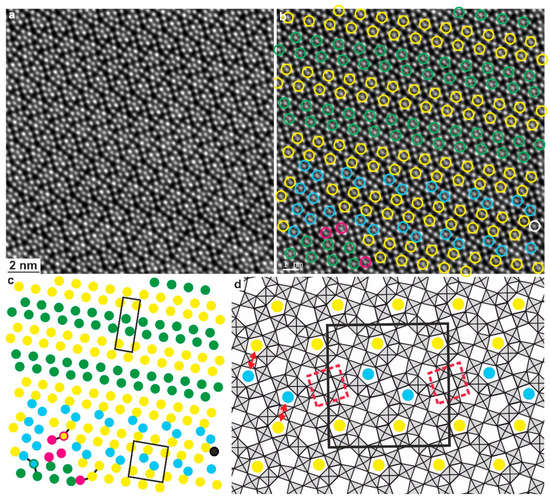
Figure 2.
(a) HAADF-STEM image of Nb18W16O93 recorded along [1] (courtesy of Prof. L. Shen, Nanjing) and (b) with the filled PTs marked as open circles. Pairs of diamond-linked pentagonal columns (PC) with the same orientation have the same color. (c) Scheme of the PCs with unit cells of Nb8W9O47 (top) and Nb12W11O63 (bottom) outlined. (d) Structural model of Nb12W11O63. Red double arrows mark two directly adjacent PCs, and dashed squares mark empty TTB units. For details, see text. Figure 2a has been published in modified form as Figure 2e in [12] under CC-BY license.
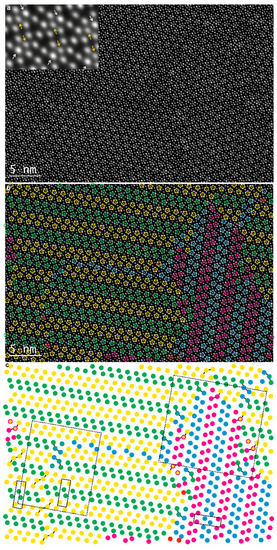
Figure 3.
(a) HAADF-STEM image of Nb18W16O93 recorded along [1] (courtesy of Prof. L. Shen, Nanjing) and (b) with the filled pentagonal tunnels (PTs) marked as open circles. (c) Scheme of the PT array. Rectangles framed by solid lines indicate unit cells of Nb8W9O47 and those framed by dotted lines represent the areas interpreted in Figure 4. The magnified area (inset in (a)) demonstrates the varying dot intensities with white arrows pointing to W-rich positions and yellow arrows to Nb-rich positions.
A larger area, which mainly contains the Nb8W9O47 structure, is shown in Figure 3. Two distinct defects that are typical for this structure occur, namely, an out-of-phase boundary on the lower left side and rotational twinning by 90° on the right side. The three-fold TTB superstructure is perfectly ordered on the upper left side (Figure 3a). The inclusion of a row of five PC pairs with perpendicular orientation (blue) causes a shift of the adjacent domains of Nb8W9O47 by 1/3 b (=bTTB), with respect to each other (Figure 3b,c). In the lower part of the boundary, the structure is semiregular; the slabs of yellow PC pairs in the two domains are connected via a chain of four diamond-linked PCs, with each slab contributing two PCs. The slabs with green PC pairs are not connected; instead, they directly neighbor an isolated yellow PC.
This structure is depicted on the lower left side of Figure 4a. Four-membered PC chains had been observed before, e.g., in zigzag out-of-phase and twin boundaries in Nb8W9O47 [3] and as a regular structural element in Nb6W8O39 (Figure 1) [4]. At the top of this boundary, the occupation of PTs is less regular and includes a three-membered PC chain, in which the middle PC belongs to two perpendicularly oriented slabs of PC pairs (blue and green). Here, a small block of six PCs with perpendicular orientation (90° rotation twin) is incorporated (light blue area). Interestingly, this block connects two slabs of green PC pairs, and the two PCs at the top and at the bottom can be regarded as part of the small section of three PC pairs (light blue area) as well as part of the connected slabs of green PCs.
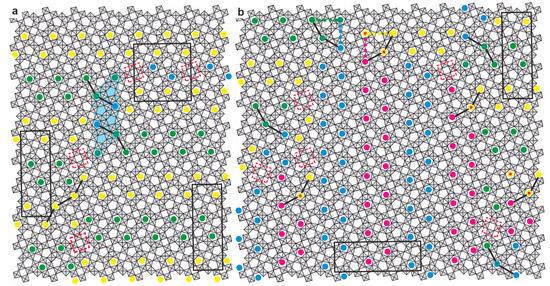
Figure 4.
Structural models of the area (a) in the lower left corner and (b) in the upper right of Figure 3a. Some unit cells of Nb8W9O47 and Nb12W11O63 are framed black, and TTB subcells with four empty PTs are dotted red. In the lower part of (a), a grain boundary is present between domains of the Nb8W9O47, which are shifted by 1/3 b with respect to each other. In (b) domains of Nb8W9O47 are rotated by 90°.
Another example for such rotational twinning appears on the right side of Figure 3, with the corresponding structural model shown in Figure 4b. In the upper part, slabs of blue and magenta PC pairs are connected to perpendicularly oriented slabs of green and yellow PC pairs. This arrangement is frequently observed at boundaries between rotational twin domains; the central PC of a triple PC chain belongs to the two perpendicular PC slabs. This is also the case for the isolated PC that is quasi an extension of the PC rows that are not directly connected. This frequently appearing array is marked by dotted lines in Figure 4b (top center) for the two units just described. It should be mentioned that such a connection of 90° rotational twin domains by three-membered PC chains was already observed in the first HRTEM investigation of this material in 1974 [3]. Similarly to here, an empty TTB cell and directly adjacent simultaneously occupied PTs were found.
As the HAADF-STEM method generates images with the intensity I increasing with the atomic number Z (I~Z2; Z contrast imaging [23,24]), the metal positions appear as bright dots, with their brightness increasing with the W content of the particular atomic column (ZW = 74 > ZNb = 41) [19,21]. Thus, the observation of the relative brightness of the individual atomic columns in regions of constant thickness provides some information about the distribution of the metals (inset in Figure 3a). The relative darkness of the metal position inside the PTs indicates that it is preferentially occupied by Nb, as is also the case in W-richer samples [21]. Thus, the preference of Nb for this position, as it was found during the structure determination of Nb8W9O47 from single-crystal X-ray diffraction data [18,25], has been preserved. This is also the case for a W-rich position that appears with high brightness (inset in Figure 3a).
The inclusion of structural units with directly adjacent PCs is a necessary means to account for the increased number of occupied PTs compelled by the decreased ratio O/ΣM. This observation is corroborated by determining the ratio O/ΣM of a rather large crystal fragment (Figure 5). As already observed in the fragments described above, this region comprises small domains with the structures of Nb8W9O47 and Nb12W11O63, which are intimately intergrown with each other and appear in different orientations. The occupied PTs in this large area were detected (Figure 5b) and counted. The whole area contains 1345 TTB cells, in which 1876 PTs are occupied. Therefore, the overall composition is (MO)1876(M10O30)1345, with a ratio O/ΣM = 2.755. This value is larger than that of the sample Nb18W16O93, with O/ΣM = 2.735, but significantly smaller than that of Nb8W9O47, with O/ΣM = 2.765.
4. Discussion
According to the evaluation of the HAADF-STEM images, the sample Nb18W16O93 comprises an intact TTB framework that hosts intimately intergrown domains of the Nb8W9O47 phase, with an increased amount of filled PTs. In the latter domains, the occupation of directly neighbored PTs by MO strings compensates for the decreased O/ΣM, as follows: (MO)x(M10O30) with x > 4/3 compared to x = 4/3 in Nb8W9O47. This is the case in the structure of Nb12W11O63 (=(MO)6(M10O30)4 with x = 1.5) that has been observed in small domains in the sample Nb18W16O93 for the first time. In fact, the ratio O/ΣM of Nb12W11O63 (2.739) is close to that of Nb18W16O93 (2.735). This dense occupation of PTs, violating the first rule for a stable array of PCs, is enforced by the decreased O content that must be somehow adjusted by structural adaptions. Nonetheless, the most stable PC arrangement, namely, that of Nb8W9O47, is still the dominating structure in the sample Nb18W16O93, and is present in many domains, with a typical diameter of several 10 nm. In contrast, the O-poorer domains are smaller and heavily disordered, with regular structures appearing as rather small inclusions only. Both the TTB superstructures Nb8W9O47 and Nb12W11O63 do occur in different orientation variants (Figure 5b), with the respective nanometer-sized domains coherently intergrown with each other. This flexibility is caused by the unaffected TTB-type framework, with the structural modifications realized by filling PTs in different ways.
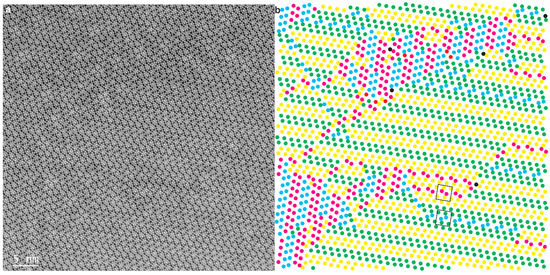
Figure 5.
(a) HAADF-STEM image (courtesy of Prof. L. Shen, Nanjing) and (b) interpretation with PCs shown as filled circles. Two cells of Nb12W11O63 in adjacent domains are framed.
Note that on the well-investigated W-rich side of Nb8W9O47 (O/SM > 2.765 (=47:17)), the O surplus is accommodated by forming little ordered structures with a lower density of filled PTs. An example of this is the Nb6W8O39 structure (O/ΣM = 2.786) with four-membered PC chains (Figure 1) [4], which are intergrown with domains, or even single units, of Nb4W7O31 (O/ΣM = 2.818) [18,26]. It is important to state that the PCs in all TTB-based structures and variants tend to be connected to form pairs or chains via the diamond link, rather than being isolated or directly adjacent. In the structure Nb12W11O63, corresponding to (MO)6(M10O30)4, diamond-linked PCs pairs are directly adjacent to each other, which might represent a moderately stable arrangement, as it is present as an intact structure in nanodomains.
5. Conclusions
The present HAADF-STEM investigation reveals that the sample Nb18W16O93 cannot be considered as a separate phase. The arrangement of PCs embedded in a perfectly ordered TTB substructure corresponds, in wide areas, to that of the well-known and stable phase Nb8W9O47, but the arrangement is only slightly ordered in small domains. No evidence for the existence of a PC array, as suggested by Stephenson for the structure of Nb18W16O93 [14] could be found. In general, most PCs are connected via the diamond link to form pairs or, less frequently, three- or four-membered chains of PCs. The decreased O content compared to Nb8W9O47 is structurally compensated by denser packing of PTs filled with MO strings. This unavoidably leads to the occupation of directly adjacent PTs, similarly to how they are presented in the structural model proposed for Nb12W11O63. This structure only appears in the investigated sample in nanometer-sized domains, but future synthetic efforts might be successful in preparing the Nb12W11O63 phase in pure form.
Funding
This research was funded by ETH Zürich. This research received no external funding.
Institutional Review Board Statement
Not applicable.
Informed Consent Statement
Informed consent was obtained from all subjects involved in the study.
Data Availability Statement
Not applicable.
Acknowledgments
Sample preparation and HAADF-STEM imaging was performed in the Jiangsu Key Laboratory of Electrochemical Energy Storage Technologies at Nanjing University of Aeronautics and Astronautics, People’s Republic of China. I am indebted to Laifa Shen for providing the HAADF-STEM images.
Conflicts of Interest
The author declares no conflict of interest.
References
- Griffith, K.J.; Wiaderek, K.M.; Cibin, G.; Marbella, L.E.; Grey, C.P. Niobium tungsten oxides for high-rate lithium-ion energy storage. Nature 2018, 559, 556–563. [Google Scholar] [CrossRef]
- Lundberg, M.; Sundberg, M.; Magnéli, A. The “pentagonal column” as a building unit in crystal and defect structures of some groups of transition metal compounds. J. Solid State Chem. 1982, 44, 32–40. [Google Scholar] [CrossRef]
- Iijima, S.; Allpress, J.G. Structural studies by high-resolution electron microscopy: Tetragonal tungsten bronze-type structures in the system Nb2O5–WO3. Acta Crystallogr. A 1974, 30, 22–29. [Google Scholar] [CrossRef]
- Krumeich, F. Order and disorder in niobium tungsten oxides of the tetragonal tungsten bronze type. Acta Crystallogr. B 1998, 54, 240–249. [Google Scholar] [CrossRef]
- Marinder, B.-O.; Hörlin, T.; Magnéli, A. Structure and ionic conductivity of Lix(MeO)4Me30O90 (Me = NbV, WVI). Mater. Res. Bull. 1979, 14, 387–392. [Google Scholar] [CrossRef]
- Montemayor, S.M.; Alvarez Mendez, A.; Martínez-de la Cruz, A.; Fuentes, A.F.; Torres-Martínez, L.M. Lithium insertion in two tetragonal tungsten bronze phases, M8W9O47 (M = Nb and Ta). J. Mater. Chem. 1998, 8, 2777–2781. [Google Scholar] [CrossRef]
- Martinez-de la Cruz, A.; Juarez Ramirez, I.; Torres Gonzalez, L.C. Electrochemical Li insertion in Nb8-xW9+xO47 (1≤x≤6). Mater. Res. Bull. 2003, 38, 525–531. [Google Scholar] [CrossRef]
- Ye, W.; Yu, H.; Cheng, X.; Zhu, H.; Zheng, R.; Liu, T.; Long, N.; Shui, V.; Shu, J. Highly efficient lithium container based on non-Wadsley-Roth structure Nb18W16O93 nanowires for electrochemical energy storage. Electrochim. Acta 2018, 292, 331–338. [Google Scholar] [CrossRef]
- Ma, X.-H.; Cheng, L.; Li, L.-L.; Cao, X.; Ye, Y.-Y.; Wei, Y.-Y.; Wu, Y.-D.; Sha, M.-L.; Zi, Z.-F.; Dai, J.-M. Influence of cut-off voltage on the lithium storage performance of Nb12W11O63 anode. Electrochim. Acta 2020, 332, 135380. [Google Scholar] [CrossRef]
- Lakhnot, A.S.; Gupta, T.; Singh, Y.; Hundekar, P.; Jain, R.; Han, F.; Koratkar, N. Aqueous lithium-ion batteries with niobium tungsten oxide anodes for superior volumetric and rate capability. Energy Storage Mater. 2020, 27, 506–513. [Google Scholar] [CrossRef]
- Xia, R.; Sun, C.; Wang, Y.; Cunha, D.M.; Peng, H.; Zhao, K.; Huijben, M.; ten Elshof, J.E. Enhanced lithiation dynamics in nanostructured Nb18W16O93 anodes. J. Power Sources 2021, 482, 228898. [Google Scholar] [CrossRef]
- Dong, S.; Wang, Y.; Chen, C.; Shen, L.; Zhang, X. Niobium tungsten oxide in a green water-in-salt electrolyte enables ultra-stable aqueous lithium-ion capacitors. Nano-Micro Lett. 2020, 12, 168. [Google Scholar] [CrossRef]
- Liu, W.; Xu, M.; Zhu, M. Design of a niobium tungsten oxide/C micro-structured electrode for fast charging lithium-ion batteries. Inorg. Chem. Front. 2021, 8, 3998–4005. [Google Scholar] [CrossRef]
- Stephenson, N.C. A structural investigation of some stable phases in the region Nb2O5·WO3–WO3. Acta Crystallogr. B 1968, 24, 637–653. [Google Scholar] [CrossRef]
- Roth, R.S.; Waring, J.L. Phase equilibria as related to crystal structure in the system niobium pentoxide-tungsten trioxide. J. Res. Natl Bur. Stand. 1966, 70A, 281–303. [Google Scholar] [CrossRef] [PubMed]
- Horiuchi, S.; Muramatsu, K.; Matsui, Y. The crystal structure of 4Nb2O5.9WO3 studied by 1 MV high-resolution electron microscopy. Acta Crystallogr. A 1978, 34, 939–946. [Google Scholar] [CrossRef]
- Obayashi, H.; Anderson, J.S. Intermediate phases and pseudophases in the system WO3-Nb2O5: Tetragonal tungsten bronze phases. J. Solid State Chem. 1976, 17, 79–89. [Google Scholar] [CrossRef]
- Wörle, M.; Krumeich, F. On the structural complexity of tetragonal tungsten bronze-type niobium tungsten oxides. Z. Anorg. Allg. Chem. 2021, 647, 98–106. [Google Scholar] [CrossRef]
- Kirkland, A.I.; Meyer, R.R. “Indirect” high-resolution transmission electron microscopy: Aberration measurement and wavefunction reconstruction. Microsc. Microanal. 2004, 10, 401–413. [Google Scholar] [CrossRef]
- Kirkland, A.I.; Saxton, W.O. Cation segregation in Nb16W18O94 using high angle annular dark field scanning transmission electron microscopy and image processing. J. Microsc. 2002, 206, 1–6. [Google Scholar] [CrossRef] [PubMed] [Green Version]
- Krumeich, F.; Nesper, R. Oxidation products of the niobium tungsten oxide Nb4W13O47: A high-resolution scanning transmission electron microscopy study. J. Solid State Chem. 2006, 179, 1857–1863. [Google Scholar] [CrossRef]
- Krumeich, F. Intergrowth of niobium tungsten oxides of the tetragonal tungsten bronze type. Z. Naturforsch. B 2020, 75, 913–919. [Google Scholar] [CrossRef]
- Nellist, P.D. Principles of STEM imaging. In Scanning Transmission Electron Microscopy; Pennycook, S.J., Nellist, P.D., Eds.; Springer: New York, NY, USA, 2011; pp. 91–116. [Google Scholar]
- Pennycook, S.J. Seeing the atoms more clearly: STEM imaging from the Crewe era to today. Ultramicroscopy 2012, 123, 28–37. [Google Scholar] [CrossRef] [PubMed]
- Sleight, A.W. The crystal structure of Nb16W18O94, a member of a (MeO)xMeO3 family of compounds. Acta Chem. Scand. 1966, 20, 1102–1112. [Google Scholar] [CrossRef]
- Iijima, S.; Allpress, J.G. Structural studies by high-resolution electron microscopy: Coherent intergrowth of the ReO3 and tetragonal tungsten bronze structure types in the system Nb2O5–WO3. Acta Crystallogr. A 1974, 30, 29–36. [Google Scholar] [CrossRef]
Publisher’s Note: MDPI stays neutral with regard to jurisdictional claims in published maps and institutional affiliations. |
© 2021 by the author. Licensee MDPI, Basel, Switzerland. This article is an open access article distributed under the terms and conditions of the Creative Commons Attribution (CC BY) license (https://creativecommons.org/licenses/by/4.0/).